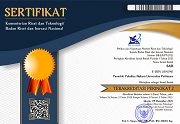General Practitioner who Provides Aesthetic Services from an Indonesian Law Perspective
 )
)
(1) Faculty of Law Christian University of Indonesia, Jakarta, Indonesia
 Corresponding Author
Corresponding Author
Abstract
Introduction: While there is a high demand for aesthetic services in Indonesia, the regulations governing them have yet to be fully established. As a result, general practitioners who wish to offer these services must navigate a complex legal landscape. This article explores the legal aspects for general practitioners looking to provide aesthetic services in Indonesia, offering valuable insights for those seeking to enter this growing field.
Purposes of the Research: This study aims to analyze the position and status of general practitioners who provide aesthetic services in Indonesia.
Methods of the Research: To achieve these objectives, the author uses normative legal research methods with analytical approach. This study uses secondary data consisting of primary legal materials and secondary legal materials obtained through literature study.
Results of the Research: The results of the study indicate that general practitioners are allowed to provide aesthetic services in accordance with defined and undefined competencies if they have attended education and training for these competencies which is organized by professional association and other institutions accredited by professional association.
Keywords
DOI
10.47268/sasi.v29i3.1236
Published
2023-06-12
How To Cite
@article{SASI1236,
author = {Susilo Yeo},
title = {General Practitioner who Provides Aesthetic Services from an Indonesian Law Perspective},
journal = {SASI},
volume = {29},
number = {3},
year = {2023},
keywords = {Aesthetic Medicine; Aesthetic Doctor; Indonesian Law},
abstract = {Introduction: While there is a high demand for aesthetic services in Indonesia, the regulations governing them have yet to be fully established. As a result, general practitioners who wish to offer these services must navigate a complex legal landscape. This article explores the legal aspects for general practitioners looking to provide aesthetic services in Indonesia, offering valuable insights for those seeking to enter this growing field.Purposes of the Research: This study aims to analyze the position and status of general practitioners who provide aesthetic services in Indonesia.Methods of the Research: To achieve these objectives, the author uses normative legal research methods with analytical approach. This study uses secondary data consisting of primary legal materials and secondary legal materials obtained through literature study.Results of the Research: The results of the study indicate that general practitioners are allowed to provide aesthetic services in accordance with defined and undefined competencies if they have attended education and training for these competencies which is organized by professional association and other institutions accredited by professional association.},
issn = {2614-2961}, pages = {409--416} doi = {10.47268/sasi.v29i3.1236},
url = {https://fhukum.unpatti.ac.id/jurnal/sasi/article/view/1236}
}
Journal Article
Adamson, Peter A, and Suzanne K Doud Galli. “Modern Concepts of Beauty.” Plastic Surgical Nursing 29, no. 1 (2009): 5. https://doi.org/10.1097/01.PSN.0000347717.98155.8d.
Boon Harold Tan, Keng. “Aesthetic Medicine: A Health Regulator’s Perspective.” Clinical Governance: An International Journal 12, no. 1 (January 30, 2007): 13–25. https://doi.org/10.1108/14777270710725364.
Cobo, Roxana. “Use of Polydioxanone Threads as an Alternative in Nonsurgical Procedures in Facial Rejuvenation.” Facial Plastic Surgery 36, no. 04 (2020): 447–52. https://doi.org/10.1055/s-0040-1714266.
Devgan, Lara, Priyanka Singh, and Kamala Durairaj. “Minimally Invasive Facial Cosmetic Procedures.” Otolaryngologic Clinics of North America 52, no. 3 (2019): 443–59. https://doi.org/10.1016/j.otc.2019.02.013.
Ekawati, Fitriana Murriya, Mora Claramita, Wahyudi Istiono, Hari Kusnanto, and Adi Heru Sutomo. “The Indonesian General Practitioners’ Perspectives on Formal Postgraduate Training in Primary Care.” Asia Pacific Family Medicine 17, no. 1 (2018): 10. https://doi.org/10.1186/s12930-018-0047-9.
Erni Yati, “Urgensi Pengaturan Praktek Estetika Medis Yang Dilakukan Dokter Umum Di Indonesia (Perbandingan Pengaturan Estetika Medis Di Singapura, Malaysia Dan Korea Selatan)”, Aktualita 3, no. 1 (2020): 21-35, https://doi.org/10.29313/aktualita.v0i0.5827
Fittria, Anis, and Laras Fira Fauziyah. “Pertanggung jawaban pidana (Mas’uliyah Al-Jinayah) dalam malapraktik dokter di klinik kecantikan.” Journal of Islamic Studies and Humanities 7, no. 1 (August 4, 2022): 17–43. https://doi.org/10.21580/jish.v7i1.11679.
Jankowska, Aneta. “The Profession of Medical Practitioners vs Aesthetic Medicine and Dermatology Treatment Practice.” Studia Administracyjne 11 (2019): 45–53. https://doi.org/10.18276/sa.2019.11-04.
Kinney, Brian M., and Paula Lozanova. “High Intensity Focused Electromagnetic Therapy Evaluated by Magnetic Resonance Imaging: Safety and Efficacy Study of a Dual Tissue Effect Based Non-Invasive Abdominal Body Shaping: MRI EVALUATION OF ELECTROMAGNETIC THERAPY.” Lasers in Surgery and Medicine 51, no. 1 (January 2019): 40–46. https://doi.org/10.1002/lsm.23024.
Konsil Kedokteran Indonesia. Disiplin profesional dokter dan dokter gigi, 4 (2011).
Konsil Kedokteran Indonesia. Standar Kompetensi Dokter Indonesia, 2012.
Legrand, Jean-Jacques. “Aesthetic Medicine: A Booming Medical Activity.” Journal of Cosmetic Dermatology 2, no. 1 (January 2003): 1–1. https://doi.org/10.1111/j.1473-2130.2003.00018.x.
Malik, Faissal. “Tinjauan terhadap teori positivisme hukum dalam sistem peradilan pidana Indonesia.” Jurnal Pendidikan Kewarganegaraan Undiksha 9, no. 1 (2021): 9. https://doi.org/10.23887/jpku.v9i1.31488.
Noor, Syafri Ramjaya. “Tanggung jawab dokter spesialis kecantikan dalam perjanjian terapeutik dikaitkan dengan hak konsumen pengguna klinik kecantikan.” Jurnal Ilmiah Mahasiswa Bidang Hukum Keperdataan 4, no. 3 (2020): 12.
Prendergast, Peter M. “Defining Aesthetic Medicine.” In Aesthetic Medicine, edited by Peter M. Prendergast and Melvin A. Shiffman, 3–5. Berlin, Heidelberg: Springer Berlin Heidelberg, 2012. https://doi.org/10.1007/978-3-642-20113-4_1.
Samadi, Pouria, Mohsen Sheykhhasan, and Hamed Manoochehri Khoshinani. “The Use of Platelet-Rich Plasma in Aesthetic and Regenerative Medicine: A Comprehensive Review.” Aesthetic Plastic Surgery 43, no. 3 (2019): 803–14. https://doi.org/10.1007/s00266-018-1293-9.
Sari, Siska Diana. “Perlindungan hukum warga negara dalam praktek Medical Aesthetic Tourism.” Jurnal Global Citizen : Jurnal Ilmiah Kajian Pendidikan Kewarganegaraan 8, no. 2 (2019). https://doi.org/10.33061/jgz.v7i2.3372.
Suminar, Sri Ratna, and H. M. Faiz Mufidi. “The Indonesian Law Perspective on the Authority of Beauty Practitioners in Performing Aesthetic Plastic Surgery.” In Proceedings of the Social and Humaniora Research Symposium (SoRes 2018). Bandung, Indonesia: Atlantis Press, 2019. https://doi.org/10.2991/sores-18.2019.13.
Syah, Nur A, Chris Roberts, Alison Jones, Lyndal Trevena, and Koshila Kumar. “Perceptions of Indonesian General Practitioners in Maintaining Standards of Medical Practice at a Time of Health Reform.” Family Practice 32, no. 5 (2015): 584–90. https://doi.org/10.1093/fampra/cmv057.
Book
Bachtiar, Bachtiar. Metode Penelitian Hukum. 1st ed. Tangerang Selatan: UNPAM PRESS, n.d.
Ibrahim, Johnny. Teori & Metode Penelitian Hukum Normatif Edisi Revisi. Malang: Bayumedia Publishing, 2013.
Soekanto, Soerjono, and Sri Mamudji. Penelitian Hukum Normatif : Suatu Tinjauan Singkat. 1st ed. Jakarta: Rajawali Pers, 2009.
Thesis, Web Page, and Others
Perhimpunan Dokter Anti Penuaan, Wellness, Estetik & Regeneratif Indonesia. “Sejarah PERDAWERI.” Accessed November 27, 2022. http://www.perdaweri.org/sejarah/.
Perhimpunan Dokter Umum Indonesia. “Pages - Profil PDUI.”. Accessed November 27, 2022. https://www.pdui-pusat.org/pages/profil-pdui.
| Dublin Core | PKP Metadata Items | Metadata for this Document | |
| 1. | Title | Title of document | General Practitioner who Provides Aesthetic Services from an Indonesian Law Perspective |
| 2. | Creator | Author's name, affiliation, country | Susilo Kurniawan Yeo; Faculty of Law Christian University of Indonesia, Jakarta; Indonesia |
| 3. | Subject | Discipline(s) | |
| 3. | Subject | Keyword(s) | Aesthetic Medicine; Aesthetic Doctor; Indonesian Law |
| 4. | Description | Abstract | Introduction: While there is a high demand for aesthetic services in Indonesia, the regulations governing them have yet to be fully established. As a result, general practitioners who wish to offer these services must navigate a complex legal landscape. This article explores the legal aspects for general practitioners looking to provide aesthetic services in Indonesia, offering valuable insights for those seeking to enter this growing field.Purposes of the Research: This study aims to analyze the position and status of general practitioners who provide aesthetic services in Indonesia.Methods of the Research: To achieve these objectives, the author uses normative legal research methods with analytical approach. This study uses secondary data consisting of primary legal materials and secondary legal materials obtained through literature study.Results of the Research: The results of the study indicate that general practitioners are allowed to provide aesthetic services in accordance with defined and undefined competencies if they have attended education and training for these competencies which is organized by professional association and other institutions accredited by professional association. |
| 5. | Publisher | Organizing agency, location | Faculty of Law, Universitas Pattimura |
| 6. | Contributor | Sponsor(s) | Faculty of Law Christian University of Indonesia, Jakarta |
| 7. | Date | (YYYY-MM-DD) | 2023-06-12 |
| 8. | Type | Status & genre | Peer-reviewed Article |
| 8. | Type | Type | |
| 9. | Format | File format | |
| 10. | Identifier | Uniform Resource Identifier | https://fhukum.unpatti.ac.id/jurnal/sasi/article/view/1236 |
| 10. | Identifier | Digital Object Identifier | 10.47268/sasi.v29i3.1236 |
| 11. | Source | Title; vol., no. (year) | SASI; Volume 29 Issue 3, September 2023 |
| 12. | Language | English=en | en |
| 13. | Relation | Supp. Files | |
| 14. | Coverage | Geo-spatial location, chronological period, research sample (gender, age, etc.) | |
| 15. | Rights | Copyright and permissions | Copyright: Authors who publish their manuscripts in this Journal agree to the following conditions: 1. The copyright in each article belongs to the author, as well as the right to patent. 2. Authors can enter into separate, additional contractual arrangements for the non-exclusive distribution of the journal's published version of the work (e.g., post it to an institutional repository or publish it in a book), with an acknowledgment of its initial publication in this journal. 3. Authors are permitted and encouraged to post their work online (e.g., in institutional repositories or on their website) before and during the submission process, as it can lead to productive exchanges, as well as earlier and greater citation of published work. 4. Authors have the right to self-archiving of the article (Author Self-Archiving Policy)
License: The SASI Journal is disseminated based on the Creative Commons Attribution-NonCommercial 4.0 International license terms. This license allows anyone to copy and redistribute this material in any form or format, compose, modify, and make derivatives of this material for any purpose. You cannot use this material for commercial purposes. You must specify an appropriate name, include a link to the license, and certify that any changes have been made. You can do this in a way that is appropriate but does not imply that the licensor supports you or your use.
|
Copyright (c) 2023 Susilo Kurniawan Yeo

This work is licensed under a Creative Commons Attribution-NonCommercial 4.0 International License.

 : 2738 times
: 2738 times Download : 1476 times
Download : 1476 times
















